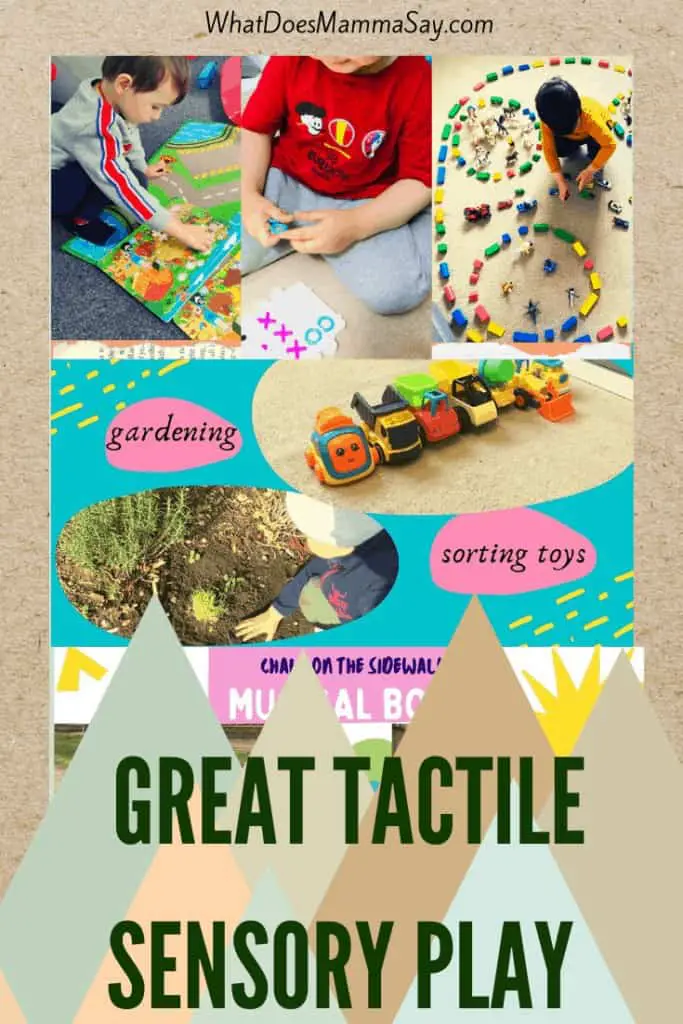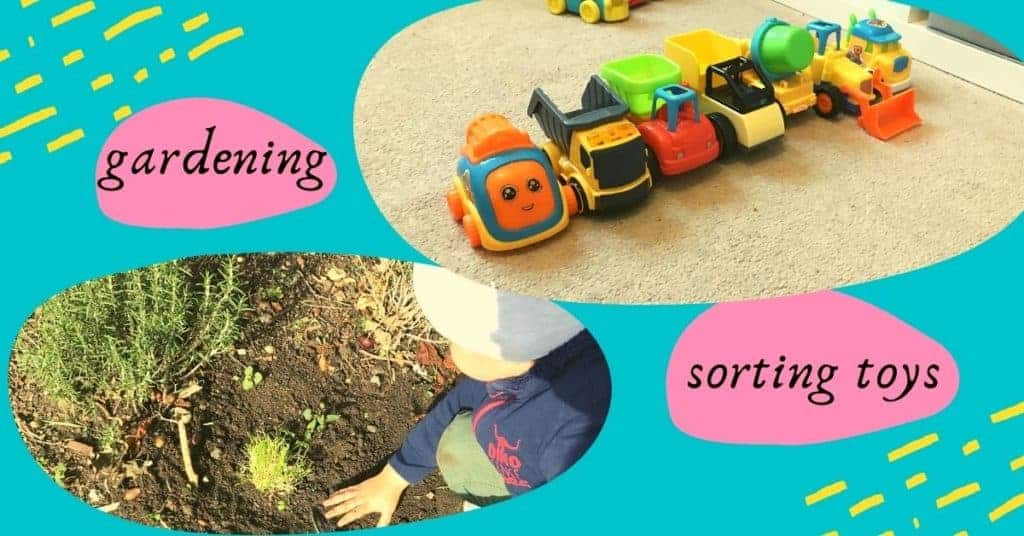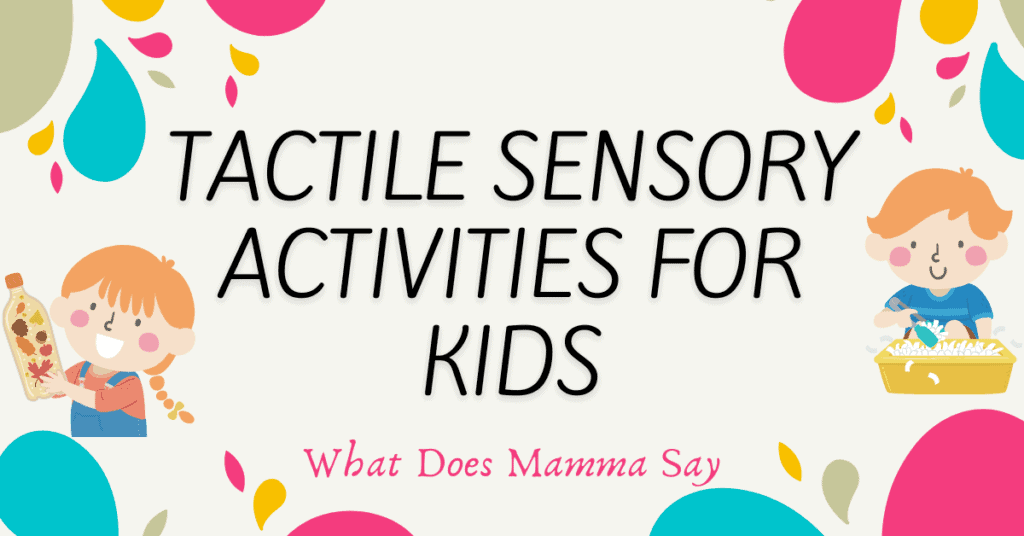In this article you read about sensory play and toys and discover hands-on ideas for tactile sensory activities to try at home with kids.
Sensory Play Experiment
All human experiences develop through interaction with their environment (Ingold, 2000). Tim Ingold in The Perception of the Environment describes humans as ‘dwellers’, suggesting that children’s thoughts, movements, identity, and culture emerge from their interaction with their environment.
Sensory play allows children to make sense of the environment around and to appropriately act on it. It can and should take place in a natural environment as this “generates instant feedback to the entire body through movement” (Jostein R. Sanderud).

A certain study examined that sensory play with fruits and vegetables influenced preschool children to eat more fruit and vegetables. The experiments simply exposed children to texture and involved no tasting.
“The aim of the study was to examine whether pre-school children who took part in multisensory play activity with fruits and vegetables, without pressure to eat or to try the foods, would taste more fruit and vegetables than children engaged in a non-food activity or those visually exposed to the activity.”(Helen Coulthard & Annemarie Sealy)
Multi-Sensory Toys
Choosing multi-sensory toys (toys that require the use of ears, eyes, and fingertips at the same time) for your child can help him be more aware of himself, be able to use more than one sense at a time, and improve fine and gross motor skills among other benefits.
This post may contain affiliate links and I may earn a small commission when you click on the links at no additional cost to you. As an Amazon Affiliate, I earn from qualifying purchases. You can read my full disclosure here.
“What can playtime with multi-sensory toys teach children of all ability levels?
- Awareness of body movement and surroundings
- Creative self-expression through making noises, flashing lights, etc.
- Ability to use more than one sense at a time
- Independence through self-directed play (many toys require little to no adult supervision when in use)
- Peer interaction (many toys allow for more than one player at a time)
- Stronger fine and gross motor skills
- Understanding of cause and effect “
(cited from Exceptional Parent, Oct 2011; 41 (4p))
These are only some of the benefits of sensory play that I’ve researched. But I invite you all to research it further and discover how you can help your child even more.

Tactile sensory activities for children
1. Sandpit – whether inside or out, playing with sand is a great activity that stimulates children and helps them develop their creativity as well. Kinetic sand is the best for us as we play inside.
My son gathers some scoops, containers, and cars and starts playing for more than 30 minutes without getting bored. We also made dinosaurs sand eggs and helped them hatch. I hide dinosaurs inside first and my son has to guess how many dinosaurs I hid.
2. Mud pies – just like sand, mud is a great resource for sensory play. If you are lucky enough to have a garden, then all you need is some water and some sticks, leaves and tiny containers of course. Fun guaranteed!
But we don’t have a garden, only a communal one so we must walk around to collect all ingredients first( and it takes a lot). We choose pebbles, leaves, sticks. And then we must learn to share because all kids want to be a part of the cooking game!

3. Handprints – using finger paint is the best way for kids to explore colours in my opinion. Just make sure to protect furniture and carpets as it gets really messy. It does in our case! Once those little fingers can get in there, there is no stopping them!
To make memorable, make handprints and keep as childhood memories. Try handprints on a nice tray to actually use around the house, on paper and frame it, on your child’s furniture etc. The idea is to create memories!
4. Mixing – I use cooking ingredients, but you can also try mixing elements you find outdoors: leaves, dirt, twigs, flowers, pebbles, sand. Finding these elements is a great activity in itself if you choose to play the game outdoors.
Let your child use his hands and mix all of them together, feeling their different textures. I did this indoors too with flour, chickpeas, rice, and beans, and my toddler played for more than 20 minutes.
5. Play in the sprinklers – on a hot summer day this is by far the best activity for kids to play outdoor. Children try to touch the water drops, run after them, drink them, splash in the puddles, you name it.
My son loves to do it and I join him too. He gets all wet! But he also learned the difference between moist, wet, and soaking wet.

6. Pebble painting – I love this activity. First of all, because we must first go out and collect pebbles. We have lots of fun doing it and it’s hard to stop my son from bringing in a whole backpack of them.
And then, because painting on pebbles is much more interesting than on paper. The different texture, the fact that you must hold it and manipulate it, getting dirt are all part of the fun.
7. Playdough on paper – Together with sand and mud, playdough is on our favourite sensory activities list. Squashing and squeezing help my son relax and he enjoys it as an afternoon activity when we have our quiet time routine.
Apart from using shapes when playing with playdough, my son likes to fill in the drawings on paper I make for him. Probably because he gets to squeeze his fingers in there, or press it on paper or sometimes make a big pile of playdough.
8. Play with flour – if you don’t feel adventurous, don’t do it! Flour is messy! Flour gets everywhere! Don’t! But we did it! We played together. On the living room floor!! And at first, my toddler was shy about it.

He simply ran his fingers through it, then started to pat it, and then, then he started throwing it in the air!
9. Have a picnic outside – playing outside is a sensory activity, that is important to remember! Explore the outdoors more often! Experimenting with different textures, various smells and sights are amazing sensorial experiences. You are helping your child make sense of the world.
10. Bubble foam – it cannot get more entertaining than this. Mix bubble bath and water really well and there you have it. Pour it in the sink or in a large bowl, in the bath, anywhere, and let your little one play away.
11. Flashlight play –The first time my son played with a flashligh was magical! He was hooked! He tried to catch the light, he wiggled it, noticed how it got larger or smaller, he was fascinated!
Then one day I took one of his toy boxes, removed the bottom lid and placed a toy there. I put the flashlight on the floor, pointing towards the toy. My son was on the other side and noticed the animal’s shadow. He was thrilled and we kept playing this for more than 20 min. I recommend it wholeheartedly!

12. Musical books – an auditory activity that engages the child greatly. My son used to love to turn the pages and listen to the next musical instrument. He was about 9 months when we introduced musical books.
You can also choose musical books with buttons that the child needs to push to make sounds, an activity which will also practices fine motor skills.
13. Chalk on the sidewalk – this is a haptic activity, through which the child feels rough and smooth surfaces. There are however many other haptic activities which you can try: pen on paper, lego, bubbles, slinkies, pipe cleaners, koosh balls, anything that involves active exploration of objects and surfaces.

14. A surprise box of toys – this is a stereognostic activity, meaning the ability to identify an object without using any of your senses, except touching. Maria Montessori called this “the sixth sense”. Which sounds great, because it involves surprises.
Blindfold your child, have him look away, close his eyes, to discover the surprise. For this activity, I use a box of very old toys that belonged to my husband. They are not the usual toys my son interacts with so the surprise is even greater. It is more difficult to identify toys that he doesn’t usually play with and this is exciting for him.
15. Smelling jars – I personally love this activity. In small jars I put various spices, cooked food, raw vegetables, make sure to chop them really well so that you don’t give the child any clues.
Smaller children will make use of their smell but also visual sense and they may throw wild guesses at you, but they will have great fun and they will learn how to identify according to smell. My son is 3 and can recognize my perfume on someone else now so their senses start to get really sharp.

16. Gardening – even if you don’t have a garden, planting is something I encourage all parents to do with their children. Not only do they experience the world around through various senses, but they also learn to care for nature and to respect it.
17. Sorting – visual activity to help children discriminate between different objects. Choose objects of the same colour but different sizes. Or objects of the same colour but different shapes.
Let your child sort them according to that one distinct characteristic. Anything can be sorted if you use your imagination a little!

We share all of our ideas on our Facebook group Learning Activities for Kids.
Resources:
Sanderud, J. Ronning, Mutual experiences: understanding children’s play in nature through sensory ethnography
Coulthard, H. & Sealy A. , Play with your food! Sensory play is associated with tasting of fruits and vegetables in preschool children
Ingold, T. , 2001, The Perception of the Environment: essays on livelihood, dwelling and skill
Piaget, J. , 1962, Play, Dreams and Imitation in Childhood
Listen And Feel: Multi-Sensory Toys Help The Mind Grow Strong by Exceptional Parent, Oct 2011

Hi. I am Monica, an experienced ESL teacher and early years student, mother to a preschooler and passionate reader.


I don’t have a kid yet (my hubby’s children are teenagers now), and if I have, I would let my child play any toys above you’ve mentioned but not the computer or mobile phones. Interaction with other kids is also important.
play is a hands-on approach which I believe is a fantastic way to learn about life and fine-tuning our motor skills, etc…
As a preschool teacher, I try to implement play activities as much as possible and the kids love it!
This is a great list of play activities. I love sensory play activities and musical play.
You have a lot of great activities on this post. Play based learning truly is the best way for little kids to begin learning about the world around them. Nothing beats getting your hands a little dirty while gardening or playing in sand, building, pretending, taking turns with friends.
These are great ideas! My son especially loves playing with sand!
I always encourage my youngest in learning through play and she enjoys it very much. Thanks for sharing other ideas for learning.
Such great play activities for learning….
So many great ideas here! Some of the other things we used for learning fun when my girls were little was practicing/learning math with food (how many carrot sticks do you have left? Let’s count them! How many if you eat one? What if I add two more? Which do you have more of, carrots or raisins?), practicing math/counting/colors with their 10×10 abacus, color-sorting with their stacking cups and blocks, learning about fractions and shapes when folding laundry (what shape is the washcloth? What If I fold it like this? – now we have two halves, two rectangles – oh look, if we fold it in half again, we have four smaller squares!) etc.